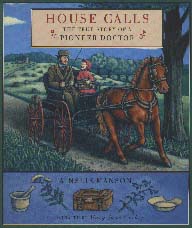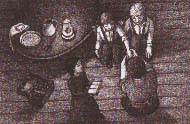| ________________
CM . . .
. Volume VIII Number 11 . . . . February 1, 2002
exerpt:
Do doctors even make house calls these days? Ainslie Manson's House Calls: The True Story of a Pioneer Doctor returns readers to a time when doctors visited out more often than not. These good men selflessly served several far-flung communities and were general practitioners in the truest sense. Far from being non-specialists, they specialized in everything: surgery, dentistry, obstetrics, pharmacy, pathology, and then some, acting as postman, justice of the peace, and friend as the need arose. Available day or night at a time when pagers and cell phones were nonexistent, doctors earned the loyalty of their communities. House Calls is the story of 1800s doctor John Hutchison, so beloved by members of his community that they volunteer the material and labour to build him a house when personal circumstances force him to leave.
It's an optimistic, true story, one that will likely find itself fighting a cynical modern world. Where can today's children find examples to match the ideal doctor-patient relationship and community spirit portrayed in the book? The too-good-to-believe quality of the story is reinforced by characters who are relentlessly one-dimensional: the good Dr. Hutchison is a grave and kind man, quietly heroic; young Kathleen is an earnest and eager learner; the rest are uniformly agreeable and grateful. The illustrations don't help; Mary Jane Gerber's static, monochrome illustrations do little to evoke a sense of real people or place, and drain an already small reserve of energy (provided mostly by Kathleen's sprightly voice). The story is best taken as a framework for the introduction of a wealth of information. As Kathleen learns about doctoring in the 1800s, so readers learn as well. But as readers, we're given so much more: Manson also introduces to us the details that Kathleen lives - buggies and corduroy roads, pioneer housing, entertainment, beliefs and attitudes, including the chauvinism that compels Kathleen to keep her ambitions secret. Plenty of extras provide perspective as well: "The Doctor's Bag" is a recurring box containing brief descriptions and pictures of the period's doctor tools, while "The Medicine Garden" gives examples of the plants harvested by the settlers for medicinal use. And, lest we wax too romantic about the past, additional boxes focus attention on some of the grimmer realities of pioneer life. The novelty of washing hands, the prevalence of diseases such as consumption (tuberculosis) and ague, the practice of amputation without anesthetic and the common occurrence of death say much about the state of medical knowledge. Similarly, two boxes on women and medicine remind readers of past attitudes. It's a lot of valuable, even indispensable, content packed into too short a book. As many as three elements on a page -- in addition to the story -- compete for the reader's attention. The book closes with a glossary and both online and traditional references directing readers to more information. The epilogue completes the stories both of Dr. Hutchison's life and house, and in the way of the best information books, reinforces written history with a tangible connection to the present. Recommended Cora
Lee is a Vancouver writer and editor
To comment on this
title or this review, send mail to cm@umanitoba.ca.
Copyright © the Manitoba Library Association. Reproduction for personal
use is permitted only if this copyright notice is maintained. Any other
reproduction is prohibited without permission.
Published by
NEXT REVIEW |TABLE OF CONTENTS FOR THIS ISSUE - February 1, 2002.
AUTHORS
| TITLES | MEDIA REVIEWS
| PROFILES
| BACK ISSUES
| SEARCH | CMARCHIVE
| HOME
|

